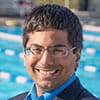Olympians Katie Ledecky and Simone Manuel Needed a Pool Last Year. This USMS Member Lent Them His
The Olympic Club member Tod Spieker let the two use his backyard pool during the coronavirus pandemic
Katie Ledecky and Simone Manuel can credit a U.S. Masters Swimming member for a small part of their success at the 2020 Tokyo Olympics.
The Olympic Club member Tod Spieker let Ledecky and Manuel use his two-lane, 25-yard backyard pool for three months after the pools they had been training in throughout the Bay Area had been shut down because of the coronavirus pandemic.
“What went through my mind [after getting a call from their coach] was that I was not in any way, shape, or form going to deny these ladies the opportunity to train during this pandemic crisis and pool closures,” Spieker says. “I wanted to help the people. These are two very high-profile swimmers who needed water, and my pool checked virtually all the necessary boxes.”
He isn’t overstating his case.
His pool is 20 feet wide with large gutters to keep wake from splashing back into swimmers, has separate holes on its deck to set up backstroke flags the proper distance for a competition in a yards pool and a meters pool, and has synchronized digital pace clocks on both ends of the pool, which allows swimmers to do repeats with an odd number of lengths (25s and 75s).
Spieker’s pool is fitting for someone who’s had a life in the sport as he has.
He swam 1968-71 at UCLA, where he was an All-American backstroker, and started participating in Masters competitions in 1977. He set 62 USMS individual records and recorded 332 individual Top 10 times before he stopped competing for health reasons more than a decade ago. He still swims three or four times a week, doing 2,000 to 2,500 yards in each session.
Ledecky and Manuel have trained and competed in some of the finest pools in the world, but they found something in Spieker’s pool they couldn’t anywhere else at the time.
“It was more than just a pool for them at that point,” their coach, Greg Meehan, who was also their coach at Stanford University and will be Team USA’s head women’s coach at the Olympics, told NBC Sports. “It was an opportunity for normalcy amid all the chaos that was going on in the world.”
A few days after they started swimming at Spieker’s pool, which is just a few miles from Stanford’s campus, the Olympics and Olympic trials were postponed to 2021. Still, they kept coming back for their nine swim practices each week.
Swimming in Spieker’s pool helped them maintain their Olympic-caliber fitness for when pools began opening last year, giving them a head start in their preparation for this year.
Ledecky and Manuel developed friendships with Spieker’s daughter and his grandchildren. The two athletes gave Spieker’s grandchildren swim caps, and, after Ledecky signed with Reese’s in April, she gave them some candy she had received.
Spieker watched Ledecky and Manuel train occasionally and remembers a “relay” set: Manuel swam a 50 freestyle, Ledecky a 100, Manuel a 150, Ledecky a 200, Manuel a 200, and Ledecky a 500, all at as close to race pace as possible. Their only rest came while the other one was swimming.
Spieker was glad to have helped them during their time of need, but he recognizes his role in their success this summer was small.
“I wasn’t in there doing their sets for them,” he says. “They did the training. I’m glad I helped in some small way. It was a very feel-good situation for me, one of the better feel-good situations I had in all of 2020.”
Categories:
- Human Interest
SIGN UP FOR UPDATES FROM USMS
















